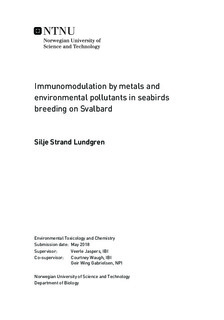| dc.description.abstract | This master thesis investigated the levels of arsenic, cadmium, chromium, copper, mercury, lead, selenium and zinc in plasma and feathers of black-legged kittiwakes (Rissa tridcatyla) (n = 17), as well as feathers of Brünnich s guillemots (Uria lomvia) (n = 13) sampled in July 2017. Secondly, this thesis aimed to determine the immunological impact pollutants may be having in the kittiwake. Samples were collected from adult birds during chick rearing period at breeding colonies (Blomstrandhalvøya and Ossian-Sarsfjellet) located in Kongsfjorden, Svalbard. Of the non-essential metals, arsenic was the most concentrated metal in plasma of kittiwakes, while mercury was the most concentrated in the feathers of kittiwakes and guillemots. Kittiwakes had significantly higher concentrations of arsenic, cadmium and mercury than guillemots, while guillemots had significantly higher concentrations of copper, lead and zinc. Immunological analysis was conducted on plasma sampled from kittiwakes in Svalbard in 2014 and 2015 (n = 17). The kittiwakes from 2014, 2015 and 2017 were all screened for avian influenza virus, and n = 4 of the kittiwakes, all sampled in 2015, were infected. microRNAs are small non-coding RNAs that have been found to be implicated in the development and function of the immune system at an increasing level. Variation in expression of a specific microRNA, miR-155, was predicted by linear models. One linear model, including both years, predicted that variation could be explained by sex of the birds (n = 5 males, n = 12 females), avian influenza virus infection of the birds (n = 4 infected, n = 13 non-infected), levels of p,p -DDE and levels of sumPCBs. A second model, including only 2015 kittiwakes (n = 10), predicted that variation in miR-155 expression could be explained by avian influenza virus infection of the birds and levels of Se, Pb and As. Both models indicate that environmental pollution might be implicated with immunomodulation and disease prevalence in the kittiwakes. The difference between sexes indicate that this effect could be sex dependent, which needs to be investigated further. To the knowledge of the author, this is the first study to observe modulation of miR-155 by pollutants in wild animals, and it would be interesting to do further research on this microRNA with other pollutants and wild species. | |

